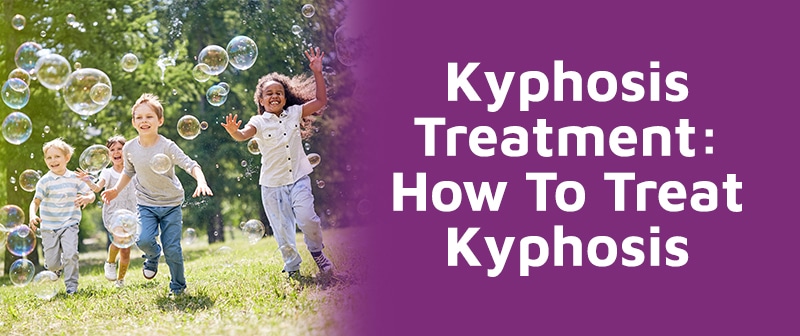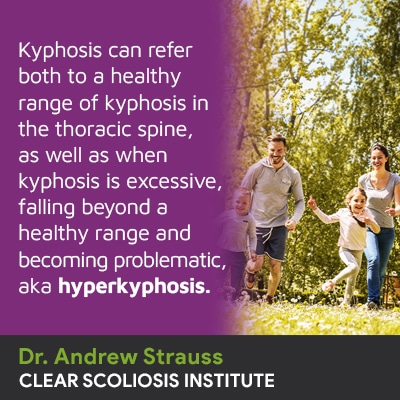
The spine’s healthy curves help it function optimally, and there are a number of spinal conditions that involve a loss of one or more of those healthy curves. The term kyphosis can refer both to the thoracic spine’s healthy outward curve, and when that curve-type becomes excessive and problematic.
Also known as roundback, because of its visual effects, kyphosis is an exaggerated outward spinal curve of the upper back. Kyphosis is treatable, but treatment needs/efficacy will be case-specific and shaped by a number of key patient/condition variables.
Before exploring the different types of kyphosis, and kyphosis treatment, let’s start by highlighting the importance of the spine’s healthy curves.
When the spine is viewed from either side, it has an‘S’ shape, and when viewed from the front and/or back, it appears straight; this is due to the spine’s healthy curves at each spinal section.
The spine’s natural curves make it more flexible, facilitate its ability to absorb stress incurred during movement, and stronger, somewhat like a coiled spring.
There are three main spinal sections, and each features a characteristic curvature type, known as lordosis and kyphosis.
The cervical spine (neck) has a natural lordotic curve; the thoracic spine (middle/upper back) features a kyphotic curve, and the lumbar spine (lower back) is lordotic.
Lordosis refers to the spine’s inward curves that bend towards the body’s center, while kyphosis refers to the spine’s outward curve that bends away from the body’s center in a reverse ‘C’ shape.
The health of each curve depends upon the health of the others; the loss of one healthy curve often causes the development of a compensatory curve in another spinal section, as the spine attempts to counteract the uneven forces introduced by the first unnatural spinal curvature.

A healthy range of kyphosis in the middle/upper back would fall between 20 and 40 degrees, and a diagnosis of kyphosis (hyperkyphosis) is commonly given at 40+ degrees, when measured between T4 and T 12.
So what types of kyphosis indicators should a person be looking for?
Each case of kyphosis is unique and shaped by a number of important patient/condition variables: patient age, condition type, severity, level of spinal rigidity, and the amount of degenerative (arthritis) changes in the affected area of the spine.
Commonly referred to as roundback, because of the excessive rounding-forward of the upper back and shoulders, this postural effect is the condition’s most noticeable, and common, symptom.
While excessive kyphosis most commonly affects the thoracic spine, it can also affect the cervical spine.
In addition to giving the body a rounded-forward appearance, it can cause varying levels of back, shoulder, and muscle pain, and when there is a degree of nerve involvement due to compression, it can cause radiating pain felt in the sides and/or chest.

Postural Kyphosis
Postural kyphosis is both the most common type and the simplest to treat, and this is because it’s not a structural condition, meaning it doesn’t involve a structural abnormality within the spine itself.
As the name indicates, it’s caused by chronic poor posture, and as a nonstructural condition, a change in body positioning can change the excessive kyphosis, impacting the unnatural spinal curve.
If a patient with postural kyphosis was to lay flat on the floor, for example, while making an active effort to straighten out their curve by pressing the entire length of the spine into the floor, the excessive kyphosis could be corrected.
Commonly diagnosed during adolescence, postural kyphosis is more prevalent in females than in males and is caused by poor posture: slouching and/or staring down at devices for long periods of time, associated with forward head posture.
Postural Kyphosis Treatment
As postural kyphosis is nonstructural, it can be easily treated with postural exercises and lifestyle guidance, and can be reversed, in most cases, by addressing the postural and movement patterns identified as problematic.
Most often, treatment will involve postural remodeling through the utilization of condition-specific physical therapy exercises that facilitate spinal extension and increasing core strength so the spine is optimally supported and stabilized by its surrounding muscles.
Scheuermann’s kyphosis, on the other hand, as a structural condition, has more-complex treatment needs.
Scheuermann’s Kyphosis
Scheuermann’s kyphosis is the most common type of structural kyphosis, and unlike postural kyphosis that can be impacted by a change in body position, no postural/position change has the power to impact the condition on a structural level.
In a healthy spine, its vertebrae (bones of the spine) are rectangular in shape, which allows them to remain stacked on top of one another in a straight and neutral alignment (adjacent vertebrae are separated by an intervertebral disc).
In people with Scheuermann’s kyphosis, one or more vertebral bodies are more triangular in shape, causing them to become wedged together and curve excessively forward; this disrupts the entire spine’s biomechanics, disrupting its ability to maintain its natural curves and alignment, and causing the excessive rounding-forward of the thoracic spine.
Like postural kyphosis, Scheuermann’s is most often diagnosed during adolescence, but unlike postural kyphosis, it’s more prevalent in males.
While additional symptoms will vary from patient to patient, Scheuermann’s kyphosis can cause varying levels of back pain, particularly during long periods of sitting, standing, or physical exertion.
Postural kyphotic curves are flexible, which is why they’re so malleable with body movement, but Scheuermann’s curves are rigid, making them more complex to treat.
Scheuermann’s Kyphosis Treatment
Due to its structural nature, treatment has to impact Scheuermann’s kyphosis, first and foremost, on a structural level, meaning that work has to be done to change the actual structure of the spine by restoring its healthy curves, natural alignment, and addressing any areas of vertebral subluxation.
So how structural kyphosis is reversed, if indeed it’s reversible, will depend on a number of variables including patient age, severity, and rigidity of the curve.
Each case is unique, which is why the complex nature of the condition necessitates the customization of effective treatment plans.
As a CLEAR-certified chiropractor, I favor a conservative chiropractic-centered treatment approach that combines multiple condition-specific treatment forms for the best potential results:
While there are no treatment guarantees, kyphosis-specific chiropractic care can facilitate structural changes within the spine itself; a series of chiropractic techniques and/or manual adjustments can alter the position of the curve’s most-tilted vertebrae back into alignment with the rest of the spine.
A variety of in-office physical therapies can help increase a patient’s core strength so the spine’s surrounding muscles can optimally support the spine, stabilize the spine, and encourage spinal extension (counteracts compression and relieves nerve pressure).
Corrective bracing, while more helpful in young patients whose spines are still growing, can help augment corrective results by pushing the spine into a corrective position, and adult bracing for hyperkyphosis has shown remarkable changes, including pain management, stopping progression, and in certain cases, curve reductions of up to 25 percent.
Treatment also involves helping patients establish a sustainable home-rehabilitation program through a series of custom-prescribed home exercises designed to further stabilize the spine for long-term results.
When it comes to excessive kyphosis, aka hyperkyphosis, whether or not a case is fully reversible will depend on factors such as patient age, condition severity, type, and level of spinal flexibility; with older patients, for whom natural age-related spinal degeneration is a factor, it can be more realistic to work towards reducing the kyphosis, rather than fully correcting it.
The spine needs its healthy curves to stay aligned, healthy, and functioning optimally, and kyphosis, aka hyperkyphosis, involves the exaggeration of one of those healthy curves, to the point of becoming problematic.
While lordosis refers to the spine’s curves that bend inwards, towards the body’s center, kyphosis refers to the spine’s outward curve, bending away from the body’s center, and when the thoracic spine’s kyphosis is 40+ degrees, this is beyond a healthy range.
Also known as roundback because of its postural effects, kyphosis causes the upper back to become excessively rounded-forward, and treatment needs are based on key factors such as patient age, condition type (postural vs structural), severity, and the level of spinal rigidity.
For patients with postural kyphosis, this type is nonstructural, highly treatable, and can be impacted by changes in posture and body position, hence why it’s simpler to treat with a variety of condition-specific physical therapies and exercises.
Conversely, structural kyphosis, the most common of which is Scheuermann’s kyphosis, involves a structural abnormality within the spine itself, and as a structural curve is more rigid, it won’t respond to a mere change in posture or position, needing chiropractic care to impact it structurally: making it more complex to treat.

CLEAR provides a unique and innovative way of understanding scoliosis. Sign up to receive facts and information you won’t find anywhere else.
